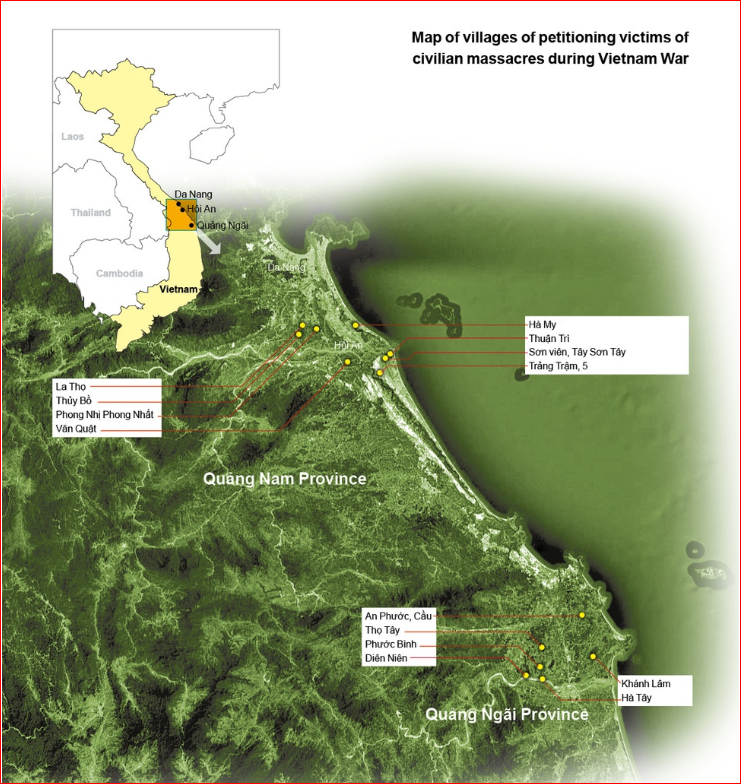hankyoreh
Links to other country sites 다른 나라 사이트 링크
The petitions of civilian victims of massacres during the Vietnamese War

National Route 1A is a major transportation artery running down the spine of Vietnam. About halfway down this highway, near the road, are the villages of Phong Nhị and Phong Nhat. A 20-minute drive to the east brings one to Ha My village, while a 15-minute drive to the west leads to Thuy Bo village. A three-hour drive south from Quảng Nam Province leads to the villages of An Phước, Cầu, Diên Niên, Phước Bình and Thọ Tây, in Quảng Ngãi Province, which are within a 15-minute drive to the east or west of the highway. The villages of Văn Quật, Sơn viên, Thuận Trì, Trảng Trậm, No. 5, La Thọ, Hà Tây, Khánh Lâm and Tây Sơn Tây are also located about an hour to either side of that same highway.
These 17 villages have several things in common. Located on broad flatlands near National Route 1A or on low hills, they’re ordinary villages that have been the home of many farmers for time immemorial. That turned out to have tragic consequences. South Korea’s 2nd Marine Division, known as the Blue Dragons, was stationed in Vietnam between 1966 and 1972. While the Blue Dragons were moving from Quảng Ngãi Province in the south to Quảng Nam Province in the north, they pulverized each of these villages, one after another. The Blue Dragons’ primary mission was defending National Route 1A; in order to facilitate their search for the People’s Liberation Armed Forces of South Vietnam (PLAF), the army controlled by the Viet Cong known as National Liberation Front, they were supposed to “evacuate” the population – which meant burning down villages and mercilessly slaughtering many of the villagers. During the period when Korean troops served in Vietnam (1964–1973), it’s estimated that 9,000 civilians were massacred and that 4,000 of them were buried in Quảng Nam Province.
Over the past 20 years, the testimony of the survivors has gradually been brought to the attention of Korean society through coverage in the Hankyoreh 21 and through the “We’re sorry, Vietnam” campaign organized by the Korea-Vietnam Peace Foundation and other civic groups. But there hasn’t been any response from the Korean government. Now, the survivors have decided to force the Korean government to make a move. They’re asking for a thorough investigation, an official apology and restitution for their losses. The first step is a petition to the Blue House. This petition was signed by 103 victims from these 17 villages, both survivors and family members of those who did not. The petition letters were personally delivered to the Blue House on Apr. 4 by two representatives of the petitioners. The Hankyoreh 21 is printing the petitions of 17 people, one from each of those 17 villages, along with the faces of all 103 of the petitioners.
The Blue House is obliged to give a response to the petitioners within at least 150 days. We can join the petitioners in solidarity and support them until the Blue House fully accepts their demands. Now is the time for us to speak, but instead of “We’re sorry, Vietnam,” we should say, “We’re with you, Vietnam.”
By Seo Bo-mi, staff reporter of Hankyoreh 21
Please direct comments or questions to [english@hani.co.kr]
Editorial・opinion
![[Column] Park Geun-hye déjà vu in Yoon Suk-yeol [Column] Park Geun-hye déjà vu in Yoon Suk-yeol](https://flexible.img.hani.co.kr/flexible/normal/500/300/imgdb/original/2024/0424/651713945113788.jpg) [Column] Park Geun-hye déjà vu in Yoon Suk-yeol
[Column] Park Geun-hye déjà vu in Yoon Suk-yeol![[Editorial] New weight of N. Korea’s nuclear threats makes dialogue all the more urgent [Editorial] New weight of N. Korea’s nuclear threats makes dialogue all the more urgent](https://flexible.img.hani.co.kr/flexible/normal/500/300/imgdb/original/2024/0424/7317139454662664.jpg) [Editorial] New weight of N. Korea’s nuclear threats makes dialogue all the more urgent
[Editorial] New weight of N. Korea’s nuclear threats makes dialogue all the more urgent- [Guest essay] The real reason Korea’s new right wants to dub Rhee a founding father
- [Column] ‘Choson’: Is it time we start referring to N. Korea in its own terms?
- [Editorial] Japan’s rewriting of history with Korea has gone too far
- [Column] The president’s questionable capacity for dialogue
- [Column] Are chaebol firms just pizza pies for families to divvy up as they please?
- [Column] Has Korea, too, crossed the Rubicon on China?
- [Correspondent’s column] In Japan’s alliance with US, echoes of its past alliances with UK
- [Editorial] Does Yoon think the Korean public is wrong?
Most viewed articles
- 1‘We must say no’: Seoul defense chief on Korean, USFK involvement in hypothetical Taiwan crisis
- 2N. Korean delegation’s trip to Iran shows how Pyongyang is leveraging ties with Moscow
- 346% of cases of violence against women in Korea perpetrated by intimate partner, study finds
- 4Amnesty notes ‘erosion’ of freedom of expression in Korea in annual human rights report
- 5‘Weddingflation’ breaks the bank for Korean couples-to-be
- 6[Column] Park Geun-hye déjà vu in Yoon Suk-yeol
- 7Will NewJeans end up collateral damage in internal feud at K-pop juggernaut Hybe?
- 8Korea sees more deaths than births for 52nd consecutive month in February
- 9“Parental care contracts” increasingly common in South Korea
- 10[Interview] Dear Korean men, It’s OK to admit you’re not always strong